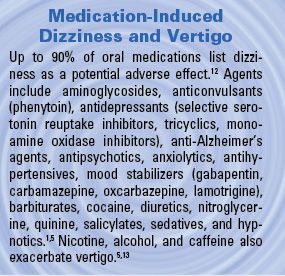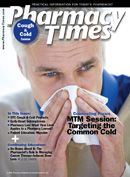Publication
Article
Pharmacy Times
Vertigo: Spin Patients Right ‘Round with Proper Treatment
Author(s):
Dr. Zanni is a psychologist and health systems consultant, Alexandria, Virginia.
Forty percent to 50% of patients who report dizziness say their environment moves or spins in relation to self episodically and without warning, making vertigo the most common balance deregulation disorder.1,2 This spinning sensation differentiates true vertigo and nonvertigo.3 In severe cases, patients report nausea, vomiting, and unsteady gait.4 Causes may be peripheral vestibular (originating in the peripheral nervous system; eg, viral ear infections) or central vestibular (originating in the central nervous system [CNS]; eg, head trauma).1,4,5
Vertigo of peripheral vestibular etiology begins abruptly, is severe, creates horizontal nystagmus, and may be precipitated by position changes. Four vestibular disorders comprise the majority:

1. Benign paroxysmal positional vertigo (BPPV) is vertigo’s most common cause, usually beginning at approximately age 51.2,6 The cause is frequently otoconia, which is calcium carbonate crystal buildup (canalith, also called ear rocks) that, when displaced into the semicircular canals of the inner ear’s vestibular labyrinth, stimulate nerve endings, creating movement sensations.7
2. Acute vestibular neuronitis, a vestibular nerve infection, is the second most common category. Its acute, severe onset lasts hours to days.5,8
3. Meniere’s disease is an inner ear fluid balance disorder that increases pressure within the inner ear’s endolymphatic system.9 Attacks tend to be intermittent with long time periods between episodes.
4. Perilymph fistula. Symptoms (vertigo, nausea, and vomiting, and sometimes tinnitus or hearing loss) result when inner ear fluid leaks into the middle ear and changes pressure. Fissures tend to have clear physical causes such as head trauma.1,10
Clinical Assessment
Symptoms associated with changing body positions almost always suggest BPPV. Symptoms with gradual onset suggest CNS etiology; sudden, severe onset suggests inner ear disease.3 Clinicians should evaluate the potential role of medications, noting if symptoms coincide with their initiation or escalating dose (Sidebar). Researchers have established a direct, positive relationship between dizziness and drug regimens among elders using 5 or more medications.11
Treatment
Treatments include pharmacotherapy, canalith repositioning procedure, vestibular rehabilitation, and diet. BPPV may resolve on its own in weeks to months6; surgical options exist for extreme cases.
Pharmacotherapy
Meclizine is the only FDAapproved agent for vertigo. Several agents are used for symptom management. Many of these are contraindicated in the elderly; caution is advised when used for this population.
Canalith repositioning procedure
This quick, brisk maneuver can physically jar canaliths from the semicircular canals to the utricle; there, crystals may dissolve or adhere to the otolithic membrane. Practitioners prescribe diazepam or other antinausea agents before the procedure because it, too, causes vertigo. Patients who cannot sustain brisk, rapid body movements are poor candidates, but this procedure has a 95% success rate.7,14
Vestibular rehabilitation therapy
This approach is employed to desensitize the brain to normal vestibular signals and then “retrain” the brain to react to other perceptual cues. Patients are taught to avoid body movements associated with vertigo (like turning the head) and compensate for loss of these movements by learning new movements (like turning the entire body).15
Dietary interventions
Patients should avoid caffeine, alcohol, sodium, and foods containing refined sugar and also maintain hydration, with fluid intake evenly distributed.5,13
Conclusion
Following treatment, patients remain at risk for recurrence. BPPV’s recurrence rates range from 26% to 50%.8 Vertigo and BPPV are common conditions, and pharmacists need to be vigilant for druginduced or drug-exacerbated vertigo.








